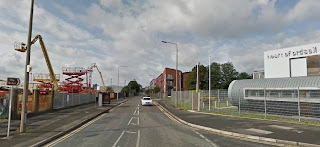Bricklayers Arms, Ashton New Road, Bradford. (c) Manchester Local Image Collection. Click here to view full image [1].
The Bricklayers Arms was a tiny Wilsons beerhouse on Ashton New Road on the Bradford-Clayton border. This 1960 photo shows the Bricklayers in the shadow of an old bridge which used to pass over to the Clayton Aniline Works. The chemical works have recently been cleared at great expense and this site is currently being developed by Manchester City into their new training campus. A works exit was next door to the beerhouse, also seen in 1960, so the little boozer will no doubt have been a popular watering hole with workers.
These 1964 and 1970 photos show its Wilsons and Bass signs, and even in the late 1970s (possibly '80s), the Bricklayers made it into the second CAMRA Greater Manchester Good Beer Guide [2]. It was included in this rather exclusive list as it offered cask bitter and mild (from electric dispense) unlike many of Manchester's pubs at the time. The old Bricklayers - one of Manchester's last true beerhouses - was lost at some point soon after and its old location was just west of the new-build bank. Since then the area has been joined by the City of Manchester Stadium, the Velodrome, a huge ASDA and of course the tram.


Former location of Bricklayers Arms, Ashton New Road. (c) Google 2013. View Larger Map.
2. Greater Manchester Good Beer Guide, CAMRA, Ed. Roger Hall (year unknown).




















+Arms+Temperance+St+Hulme+COM+FB.jpg)
+Arms+Temperance+St+Hulme+COM+FB+-+Copy.jpg)




























